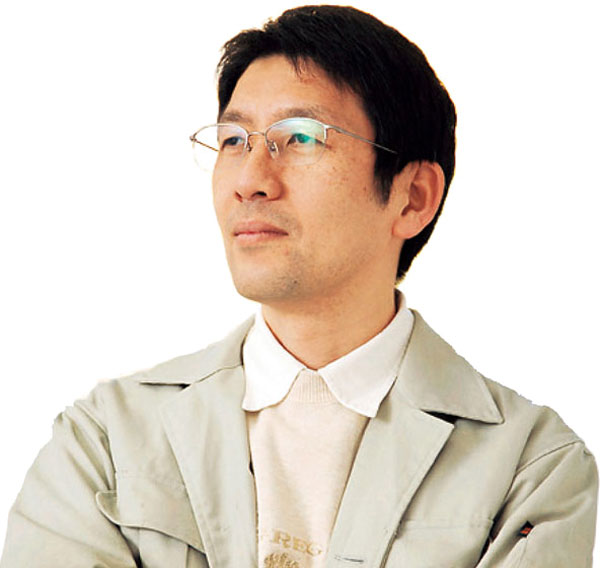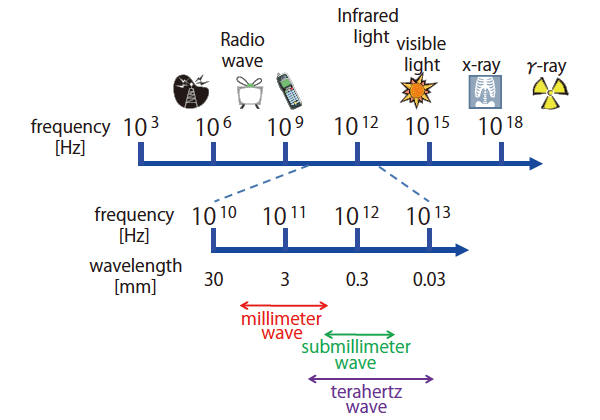World class gyrotrons, which were originally developed at the FIR UF.
- The Research Center for Development of Far-Infrared Region at the University of Fukui (FIR UF, or FIR Center) is performing research and development in the far-infrared region between radiofrequency waves and visible light using world class gyrotrons, which were originally developed at the FIR UF.
- The FIR UF attracts a great deal of attention owing to its contribution to the global evolution of the research and development in the far-infrared region through the Center’s agreements for academic exchanges and memorandums of understanding (MOUs) for collaborations with numerous domestic and overseas institutions.

Overview of FIR UF

The far-infrared (FIR), i.e., terahertz (THz), frequency region is between the radiofrequency (RF) wave region and the infrared light region. The wavelengths of the FIR region range from a few mm to a few tens of micrometers, roughly corresponding to a frequency range of 100 GHz to 10 THz.
The electromagnetic (EM) waves in the FIR/THz wave region can propagate in straight lines as light waves and penetrate materials as RF waves. This wavelength region is proving invaluable for many essential 21st-century technologies.
The FIR/THz wave region has long been regarded as an unexplored region because of the lack of powerful sources.
Rapid and great progress is expected regarding the FIR region in the very near future. The FIR UF has developed a novel high power far-infrared source “Gyrotron” and is conducting the research and development of new technologies using these world-class machines. The FIR UF is also performing research on THz science, developing novel methods of THz wave generation and new THz spectroscopic techniques. The FIR UF is now a leading research base for FIR/THz waves in Japan.
The FIR UF collaborates with domestic and overseas institutions in worldwide research activities. The center aims to fulfill its role as a world-class base for research on FIR/THz waves. Their research on high-frequency gyrotrons and the development of new FIR/THz spectroscopic techniques attracts considerable attention from around the world.
Research and Development Objectives in FIR UF
To investigate the unexplored region of EM waves
- Further improvement of our high-power FIR/THz-wave-source gyrotrons
- Development of basic technologies in the FIR region, such as high efficiency power transmission systems and high-sensitivity detectors
To extend research fields with our FIR/THz gyrotrons
- Application of FIR/THz gyrotrons to fundamental physics, materials science, life science, the development of materials with new functions, energy science, and many other fields
To develop novel methods of THz wave generation, detection, and propagation
- THz optical and spectroscopic research using broadband THz waves
To open a new academic field
- Aiming to open a new and interdisciplinary academic field in FIR/THz regions associated with fundamental physics, material science, energy science, life science, etc. using high-power FIR/THz radiation sources
Chronology of FIR UF
| Early 1980’s | Research for FIR/THz region begins. |
|---|---|
| 1984 | Successful oscillations at 70 GHz and 100 GHz by Gyrotron FU I, attracting worldwide attention as a high-frequency gyrotron | Gyrotron FU Iimage (Displayed in the entrance hall of FIR UF building) |
| 1989 | Realization of sub-millimeter wave gyrotron at 380 GHz |
| 1991 | Gyrotron oscillations at 636 GHz |
| 1992 | The Laboratory for Application of Superconducting Magnets is founded in the Faculty of Engineering. |
| 1996 | Gyrotron oscillations at 837 GHz |
| 1997 | Gyrotron oscillations at 889 GHz (world’s highest-frequency gyrotron oscillations) |
| 1999 | The FIR Center is founded by the re-organization of the Laboratory for Application of Superconducting Magnets in Faculty of Engineering per the ordinance of the Ministry of Education, Culture, Sports, Science and Technology (MEXT) |
| 2005 | World’s first gyrotron oscillations exceeding 1 THz (1013 GHz) |
| 2006 | The Cryogenic Laboratory is functionally integrated into the FIR Center. |
| 2008 | Research for THz science begins. |
| 2011 | Start of joint research scheme made open to public. |
| 2013 | Research for FIR/THz region in University of Fukui is designated by the MEXT as one of the research topics that must be performed intensively. |
| 2016 | An assistant professor is added to enhance the organization. International Research Division is established due to reorganization. |
| 2017 | An assistant professor is added to enhance the organization. |
